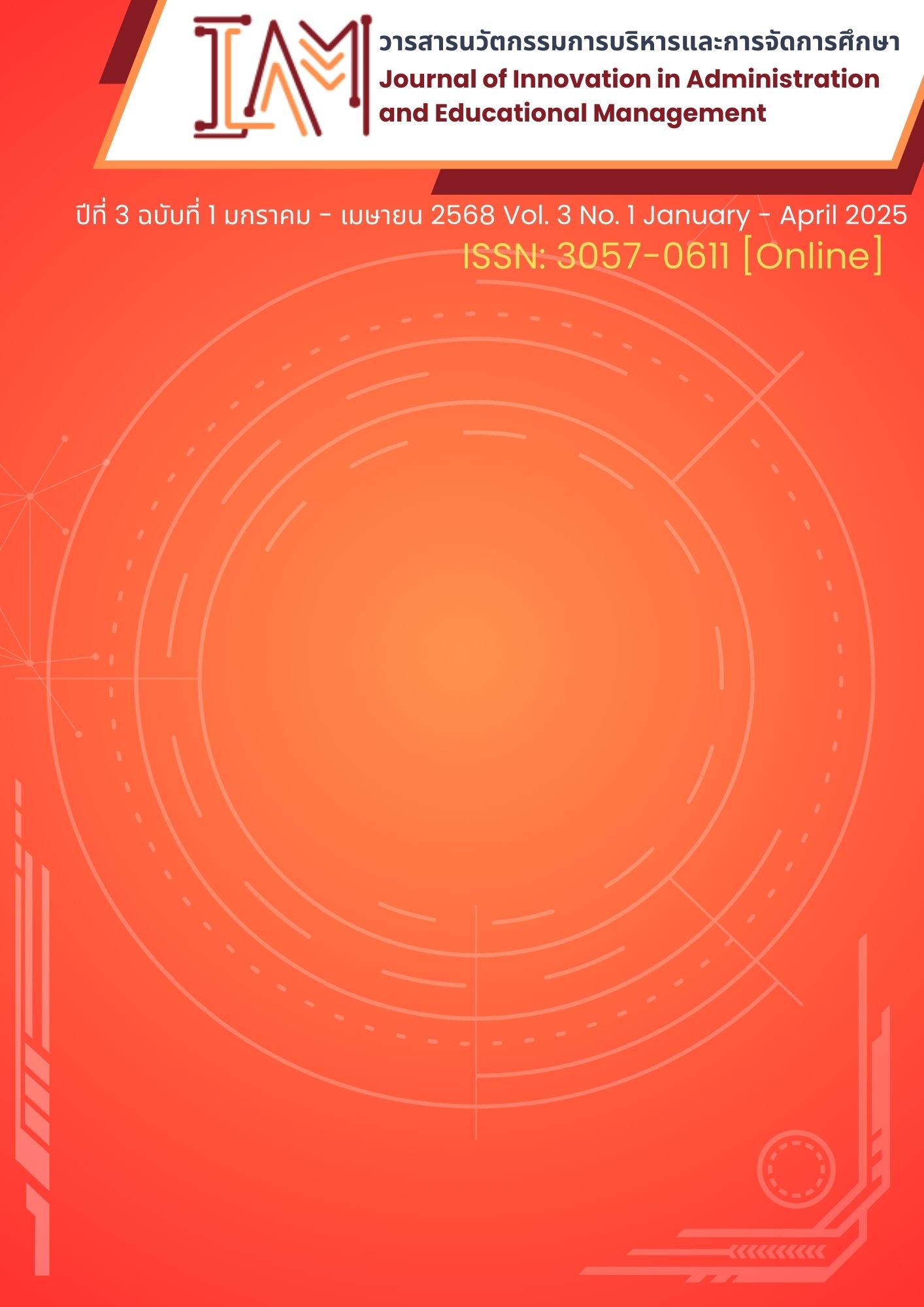Developing Analytical Thinking Skills in Division for Second Grade Students Using Open Approach Learning Activities
Keywords:
Analytical thinking skills, Division, Open Approach learning activities, Second grade students, Academic achievementAbstract
This research aimed to 1) Develop an open approach learning activity on division for Grade 2 students. 2) Compare the academic achievement on division of Grade 2 students before and after organizing the open approach learning activity. 3)Compare the analytical thinking skills of Grade 2 students before and after organizing the open approach learning activity. 4) Study the attitudes of Grade 2 students towards the open approach learning activity. The research design was a single group experimental design with pre-test and post-test. The sample group was 35 Grade 2 students in the first semester of the academic year 2024. The research instruments were the open approach learning management plan, the academic achievement test, the analytical thinking skills test, and the attitude test. The statistics used for analysis were the mean and the standard deviation. The research results found that 1) Open learning activities were effective according to the specified criteria. 2) The academic achievement of students after learning was significantly higher than before learning (p < .05). 3) The analytical thinking skills of students after learning were significantly higher than before learning (p < .05). 4) The students had a high level of attitude towards learning activities.
Downloads
References
กระทรวงศึกษาธิการ.(2560). ตัวชี้วัดและสาระการเรียนรู้แกนกลาง กลุ่มสาระการเรียนรู้คณิตศาสตร์ (ฉบับปรับปรุง พ.ศ. 2560) ตามหลักสูตรแกนกลางการศึกษาขั้นพื้นฐาน พุทธศักราช 2551. กรุงเทพฯ: โรงพิมพ์ชุมนุมสหกรณ์การเกษตรแห่งประเทศไทย.
จุฬาลักษณ์ เชื้อเงิน, เชวง ซ้อนบุญ และ สิราวรรณ จรัสรวีวัฒน์. (2562). ผลการจัดกิจกรรมการเรียนรู้วิชาคณิตศาสตร์โดยวิธีการแบบเปิดร่วมกับการใช้คำถามของบาดแฮมที่มีต่อผลสัมฤทธิ์ทางการเรียนคณิตศาสตร์และความสามารถในการแก้ปัญหาทางคณิตศาสตร์ของนักเรียนชั้นประถมศึกษาปีที่ 1. วารสารวิชาการ มหาวิทยาลัยราชภัฏบุรีรัมย์, 11(1), 42 - 58.
นิภาพร ชิงชัย. (2556). การเปรียบเทียบผลสัมฤทธิ์ทางการเรียน เรื่องการคูณ ความสามารถในการคิดวิเคราะห์ และการใฝ่เรียนรู้ของนักเรียนชั้นประถมศึกษาปีที่ 2 ที่เรียนด้วยการจัดกิจกรรมการเรียนรู้ตามแนวคิดสมองเป็นฐานและการจัดกิจกรรมการเรียนรู้แบบปกติ (วิทยานิพนธ์ปริญญามหาบัณฑิต). มหาสารคาม: มหาวิทยาลัยมหาสารคาม.
ปานทอง กุลนาถศิริ. (2555). การจัดการศึกษาคณิตศาสตร์ในศตวรรษที่ 21. สืบค้น 10 ตุลาคม 2567, จาก http://www.chonlinet.lib.buu.ac.th
วิจารณ์ พานิช. (2555). วิถีสร้างการเรียนรู้เพื่อศิษย์ในศตวรรษที่ 21. กรุงเทพฯ: ตถาตาพับลิเคชั่น.
สำนักงานคณะกรรมการการศึกษาขั้นพื้นฐาน. (2566). การทดสอบความสามารถพื้นฐานของผู้เรียนระดับชาติ (National Test: NT). สืบค้น 10 ตุลาคม 2567, จาก https://www.obec.go.th
/archives
สำนักงานเลขาธิการสภาการศึกษา กระทรวงศึกษาธิการ. (2557). แนวทางการพัฒนาการศึกษาไทยกับการเตรียมความพร้อมสู่ศตวรรษที่ 21. กรุงเทพฯ: บริษัทพริกหวานกราฟฟิคจำกัด.
สำนักงานเลขาธิการสภาการศึกษา. (2561). สภาวะการศึกษาไทยปี 2559/2560 แนวทางการปฏิรูปการศึกษาไทยเพื่อก้าวสู่ยุค Thailand 4.0. กรุงเทพฯ: สำนักงานเลขาธิการสภาการศึกษา.
อรทัย ชินาภาษ. (2560). การพัฒนารูปแบบการสอนตามแนวคิดการสร้างองค์ความรู้ตามแนวทฤษฎีคอนสตรัคติวิสต์ เพื่อพัฒนาผลสัมฤทธิ์ทางการเรียน กลุ่มสาระการเรียนรู้คณิตศาสตร์ สำหรับนักเรียนชั้นประถมศึกษาปีที่ 1. อุบลราชธานี: โรงเรียนเมืองเดช สำนักงานเขตพื้นที่การศึกษาประถมศึกษาอุบลราชธานี เขต 5.
Becker, J. P., & Shimada, S. (1997). The open-ended approach: A new proposal for teaching mathematics. Reston, VA: National Council of Teachers of Mathematics.
Bruner, J. S. (1960). The process of education. Cambridge, MA: Harvard University Press.
Hashimoto, Y., & Becker, J. P. (1999). The open approach to teaching mathematics: Creating a culture of mathematics in the classroom. In L. J. Sheffield (Ed.), Developing mathematically promising students. Reston, VA: National Council of Teachers of Mathematics.
Krulik, S. and Rudnick, J. (1993). Reasoning and problem solving: a handbook for elementary school teachers. America.
Mezirow, J. (1991). Transformative dimensions of adult learning. San Francisco: Josse.
Nohda, N. (2000). Teaching by open-approach method in Japanese mathematics classroom. In T. Nakahara & M. Koyama (Eds.), Proceedings of the 24th Conference of the International Group for the Psychology of Mathematics Education, (1), 39 – 53.
Sawada, T. (1997). Developing lesson plans. In J. P. Becker & S. Shimada (Eds.), The open-ended approach: A new proposal for teaching mathematics (pp. 25-41). Reston, VA: National Council of Teachers of Mathematics.
Schoenfeld, A. H. (1992). Learning to think mathematically: Problem solving, metacognition, and sense making in mathematics. In D. A. Grouws (Ed.), Handbook of research on mathematics teaching and learning. New York: Macmillan.
Sullivan, P., & Lilburn, P. (2002). Good questions for math teaching: Why ask them and what to ask, K - 6. Sausalito, CA: Math Solutions Publications.
Van de Walle, J. A. (2004). Elementary and middle school mathematics: Teaching developmentally. Boston: Pearson Education.
Yackel, E. (2001). Perspectives on arithmetic from classroom-based research in the United States. In J. Anghileri (Ed.), Principles and practices in arithmetic teaching. Buckingham, UK: Open University Press.
Yackel, E., Cobb, P., & Wood, T. (1991). Small-group interactions as a source of learning opportunities in second-grade mathematics. Journal for Research in Mathematics Education, 22(5), 390 - 408.
Downloads
Published
How to Cite
Issue
Section
License
Copyright (c) 2025 Journal of Innovation in Administration and Educational Management

This work is licensed under a Creative Commons Attribution-NonCommercial-NoDerivatives 4.0 International License.






